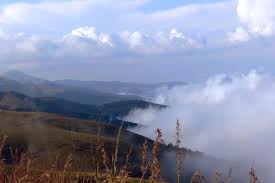
Long Tom Pass
The Pass was named after the final conventional Anglo Boer War battle that took place on the slopes of Mauchsberg between Lydenburg and Sabie, reaching a peak summit of almost 2000 meters. A replica of the Long Tom cannon stands at the Devil’s Knuckles in the pass as a reminder to tourists as to why the the pass is named Long Tom.
Today, visitors of the spectacular Long Tom Pass between Lydenburg and Sabie can negotiate the meandering 55.6km pass in relative comfort. The road passes below the summit of Mauchsberg at its highest point at an altitude of 2150m above sea level.
The road sweeps smoothly through tight corners, sharp climbs and breathless descents. It is perhaps difficult to appreciate that this mountain pass was once an extremely fearsome natural obstacle for soldiers in the running battle that took place there in September 1900 in which acts of bravery were recorded bordering on the insane.

Long Tom Pass Canon

The Long Tom on Wheels
The Boer forces had been repulsed at the battle of Bergendal after which General Botha retreated to Lydenburg. After delaying the British south of Lydenburg, he moved east up the almost non negotiable slopes of Mauchsberg with two Long Toms in the direction of what is now known as the Long Tom Pass.
General Sir Redvers Buller, wanted to block the road from Pilgrim’s Rest to Nelspruit, so it was imperative to follow Botha. Buller’s cannons which were ineffective against the 9km. reach of the Long Toms were on 2 wheels making them difficult to manoever compared to the 4 wheel mounted Long Toms and had a barrel diameter of 12.5cm.
They were effectually kept at bay by the Long Toms as the Boers were trying to escape over the mountain. As the British infantry climbed the steep slopes, carefully finding their way up the mountain in a peasoup mist, the Long Toms were inspanned and moved on, while the Boers took every opportunity to check the British advance at the same time, and then slipping away into the mist.
The Boer forces eventually reached Devil’s Knuckles, a razor backed ridge along which the track passed. It was extremely difficult, slow and dangerous to negotiate. In the meantime the British advance guard pushed on and nearly captured one of the cannons.

Mist on the Mauch'sberg and Long Tom Pass
Boer reports mention several acts of bravery as the Long Toms fought to cover the withdrawal of Botha’s men. When Sergeant Major Cox needed certain ammunition for his gun, two Irish soldiers with the Boers galloped to Lieutenant du Toit’s gun some distance away. One man collected a shell, and the other a cartridge, which under fire, they delivered to Cox’s gun. This one round caused havoc in the British ranks, and in the confusion, the Long Toms were able to withdraw. This was the last position of the canon in action and is indicated by a signpost today.

General Louis Botha Long Tom Pass
It is said that General Botha himself, when it seemed certain that there was no chance of saving one of the guns, said: “Why do you struggle with the old gun? Let it roll over the cliff!” Not recognising him, a field cornet said: “Grab the rope and pull.” He did and the gun was saved.
The Times History says: “The valour and skill of the Boer rearguard enabled the main army to retire without serious loss to itself.” On September 11, Botha successfully negotiated the pass with his force, including the Long Toms. The battle was over.
As the war moved into its guerilla phase, the need for the Long Toms was reduced. One by one they were destroyed to prevent capture by the British.

Trips ZA Logo
Talk to us about Anglo Boer War , exciting History, Wildlife, Scenic and other Tours in Mpumalanga and beyond. Call our Dream Merchants at TRIPS ZA on
013 764 1177
Email us at johnt@tripsza.com
